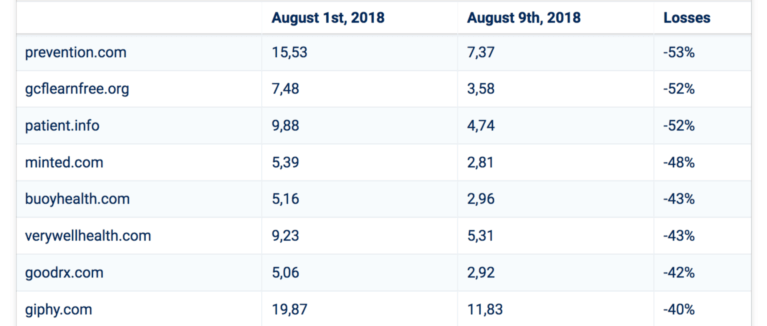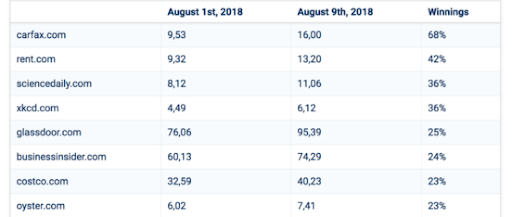
Content writing is hard.
We all know it.
You have to research in-depth articles. Source quotes from experts. And bring it all together in a uniquely compelling way.
And the truth is you could do all that work, and still see your article buried down on page 7 of Google’s SERPs.
That’s because Google looks for more than just “great content” these days.
Google wants expert, authoritative content written by trustworthy sources with experience on the topic. In this guide, we’ll show you exactly how to do that.
- Demonstrating expertise with accessible, high-level content
- Building authority with links and mentions
- Showing experience using first-hand stories and opinions
- Gaining trust with markers of credibility
We’ll start by looking at what E-E-A-T is and where it all started: as one of the biggest shake-ups the SEO world has seen in the past 10 years.
Looking for something in particular? Click a link below to jump straight to a specific section.
Table of Contents
What is E-E-A-T?
In SEO, E-E-A-T stands for Experience, Expertise, Authoritativeness, and Trustworthiness. Expertise, Authoritativeness, and Trustworthiness have been a key part of Google’s Quality Rater Guidelines ever since August 2018, with Experience being added in December of 2022.
The Quality Rater Guidelines are a 176-page guidebook to everything Google looks for in high-ranking search results.
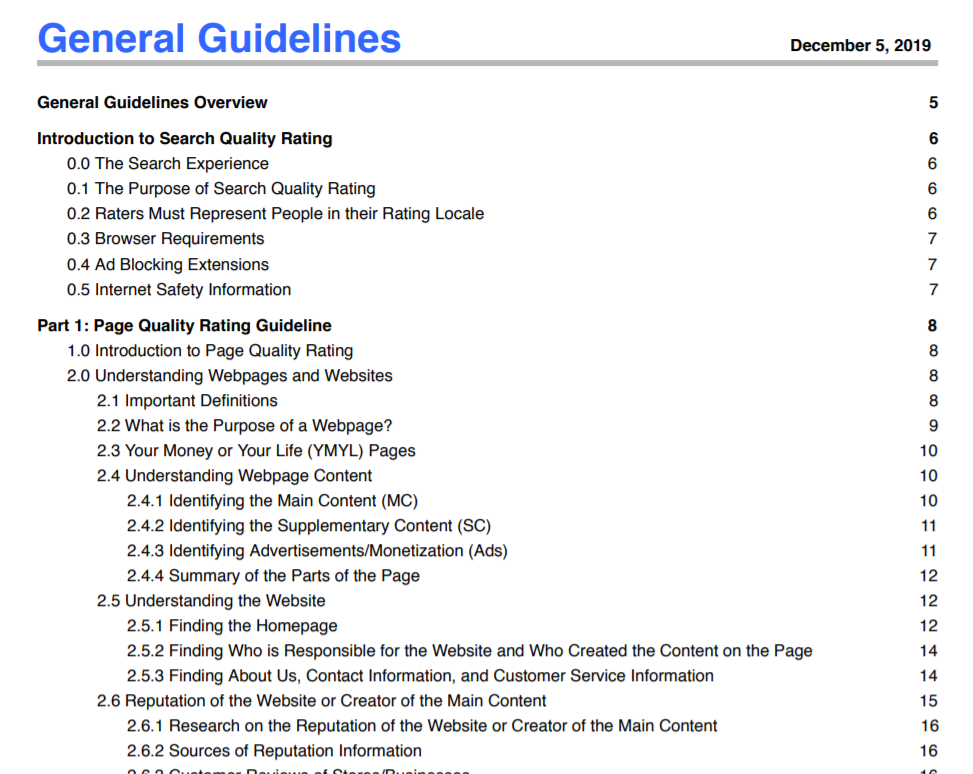
At Google, a team of approximately ten thousand search quality raters uses the guidelines to carry out spot checks that evaluate the performance of the ranking algorithms in evaluating page quality.
In a meeting with CNBC, Ben Gomes explained the role of the Quality Raters’ Guidelines in Google’s search algorithms:
“You can view the raters’ guidelines as where we want the search algorithm to go. They don’t tell you how the algorithm is ranking results, but they fundamentally show what the algorithm should do.”
Following Google’s Quality Rater Guidelines is simply your best bet for improving your performance in search. And that’s where E-E-A-T comes into play.
As Google puts it in the QRG, search results should help people. Google wants to steer people away from misleading content, slipshod advice, or fraudulent websites. Google’s goal is to show people the results that will give them the most reliable, accurate, and helpful information.
Think about it from your perspective as a user. You want information you can trust — information written by experts who are an authority in their field. And that’s what E-E-A-T is all about.
Google factors in E-E-A-T when evaluating pages that could impact a user’s happiness, health, financial well-being, or safety. Google calls these pages Your Money or Your Life pages, or YMYL for short.
It’s easy to think that this means E-E-A-T affects mainly finance and health-related websites. But that’s far from the truth.
In fact, YMYL sites include virtually any site that helps readers make an important decision, including:
- News and current events: Pages that provide news about important topics such as politics, business, international events, science, technology, and so on.
- Civics, government, and law: Information that is vital to helping the public stay informed, like information on voting, government agencies, public institutions, social services.
- Finance: Pages that provide financial advice, such as regarding investments, taxes, retirement planning, loans, banking, or insurance — especially pages that let people make purchases or transfer money online.
- Shopping: Pages that help people research or purchase goods or services — especially pages that let people buy things online.
- Health and safety: Pages that provide health-related advice on topics such as medical issues, drugs, hospitals, emergency preparedness, and so on.
- Groups of people: Pages that provide information related to groups of people, including groups based on race, ethnic origin, religion, disability, age, nationality, veteran status, and gender identity.
- Other topics: Pages that provide information on other topics relevant to major decisions in peoples’ lives, like fitness and nutrition, housing information, choosing a college, or finding a job.
Clearly, a very broad range of sites are considered YMYL sites in Google’s eyes. If you’re wondering what non-YMYL content looks like, check out this BuzzFeed list.
The truth is that if your site helps readers make an important decision that affects their health, wealth, happiness, or safety in any way, it’s a YMYL site. And even if your site doesn’t fall into this category, the principles of E-E-A-T are still important to consider.
The history of E-E-A-T
You’ve likely heard of E-A-T before, which is the original acronym used for Expertise, Authoritativeness, and Trustworthiness. It was first introduced as part of Google’s quality rater guidelines in 2014 and has since become a way for SEOs and webmasters to gauge the quality of their websites.
However, it wasn’t until 2018 when SEOs and webmasters really started paying attention to E-A-T.
How the 2018 medic update changed the SEO game
In August 2018, Google released a major update to its broad core algorithm. Across the web, major sites saw jaw-dropping reductions in organic search traffic, almost overnight:
SEOs quickly spotted a trend. Health-related sites in particular suffered from this update, leading SEO ninja Barry Schwartz to call it the Medic update.
Needless to say, the blowback from the marketing community was fierce. But in an online discussion on Twitter, Google’s Danny Sullivan gave a clue to understanding the changes:
Want to do better with a broad change? Have great content. Yeah, the same boring answer. But if you want a better idea of what we consider great content, read our raters guidelines. That's like almost 200 pages of things to consider: https://t.co/pO3AHxFVrV
— Danny Sullivan (@dannysullivan) August 1, 2018
As Sullivan points out, “create great content” is the advice SEOs and content marketers have been giving for years. But it’s not very helpful.
And it turns out, if you want a roadmap for what great content actually looks like, Google’s Quality Rater Guidelines are a great place to start.
SEO expert Jennifer Slegg has written and spoken extensively on the Quality Rater Guidelines over the years. And in August 2018, she noticed major changes to the QRG.
“The most noticeable for content creators is that Google wants their raters to not only look at the reputation of the website itself, but also the content creators themselves. This is one area that many sites fall down on. If content is created by someone with a great reputation, it makes sense for Google to rank that content higher than content created by someone with a bad reputation since it is generally a better user experience for the searcher. Great for those creators with great reputations, but does mean some work for those without a great reputation or a limited one.”
But despite the fallout, it wasn’t all bad news. Others saw their traffic soar with the 2018 update — including mostly sites that had been prioritizing expert, authoritative content from the start.
The lesson was clear: Expert content is critical. Ignore it at your own risk.
Editor’s note: with medic, Google became a “suggestion engine”
 Most analysis of the 2018 medic update focuses on “informational” health queries.
Most analysis of the 2018 medic update focuses on “informational” health queries.
What’s not talked about so much is the (huge) impact on many Ecommerce businesses at the time.
Because a big part of medic was an acceleration of Google’s trend away from being a pure “search engine” (which surfaced content based on a user’s query) to becoming what could be better described as a “suggestion engine”.
Example:
For many health-related transactional queries (think “buy supplements/pills” etc) Google simply stopped showing products on page one.
Instead, they would (and in many cases continue to) show informational articles from “trusted” sites explaining whether supplement X was good or bad.
In other words, with medic, Google disregarded the users intent (to buy the product there and then) and instead surfaced content that would “educate” them on whether or not they should buy it.
To buy the product, a user would have to skip past multiple pages of informational articles to find an actual sales page…
…or click on an ad. Because they weren’t affected.
(at the end of this guide I’ll show you steps I took to improve the E-A-T of a site in the supplement niche, and help them recover from medic)
But for now, back to Chris…
What’s happened since
Since the medic update, Google has continued to focus on various aspects of E-A-T.
Between 2018 and December 2022, Google has updated its quality rater guidelines a total of six times – the most recent one adding an extra E to the E-A-T acronym.
This was big news in the SEO community, even though the change was somewhat expected.
Over the past few years, Google has stated its increased focus on first-hand experience and clear evidence in a wide range of blog posts and articles. These things were also taken into account in various algorithm updates leading up to this change.
For example, in their search central post on the April 2021 product reviews update, Google mentioned a few useful questions to consider when writing product reviews. One of these questions focused on showing what the product is like physically and how it is used.

In December of that same year, Google added two new best practices for product reviews. The first of these best practices focused on providing evidence of your own experience with a product.

The July 2022 Product Review Update came with a guide to writing high-quality product reviews which covered many of the same points.
And the Search Central post on the Helpful Content Update referred to Google’s quality rater guidelines and stated that helpful content should clearly demonstrate first-hand experience and deep knowledge of a topic.
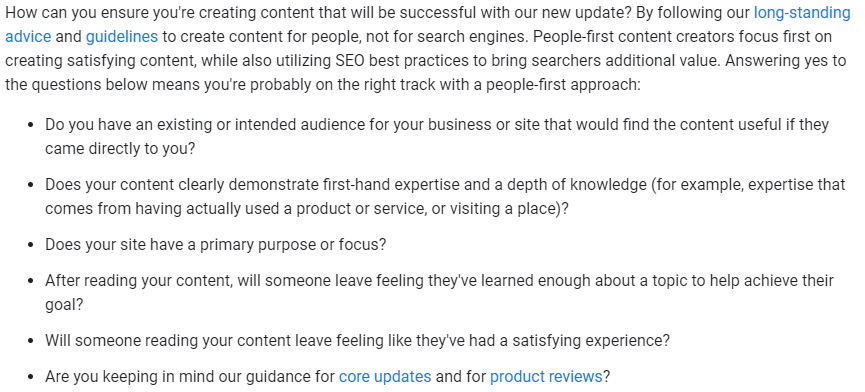
Finally, in December of 2022, Google updated their Quality Rater Guidelines, changing the section on E-A-T to include Experience as well as Expertise, Authoritativeness and Trustworthiness.
They also added an interesting graphic stating that trustworthiness should be considered the most important part of E-E-A-T.
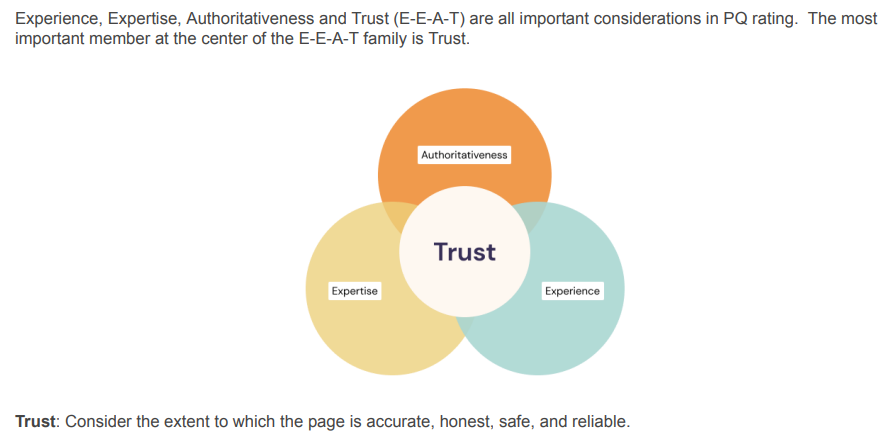
Now you know what E-E-A-T is and where it came from, it’s time to start building your E-E-A-T.
Building Expertise
Expertise means having special skills or knowledge in a particular area. That means Google looks for content created by subject matter experts who have the education, background, and qualifications to speak knowledgeably on their topic.
But expertise isn’t just about having a high level of knowledge.
True subject matter experts understand their audience. They’re great communicators who understand their readers’ interests, and get their point across in an engaging way that makes it easy for readers to digest.
Write specific, high-level content
Far too often, content on the web appears relevant to reader interests. But it’s too superficial or beginner-level to be truly valuable to the target readers you want to reach. Benji Hyam and Devesh Khanal call it mirage content.
And the answer is simple: conduct audience research to get to know your readers at a deep level. You’ll be able to craft specific, actionable content that’s relevant to your readers’ needs, like the growth studies Segment publishes on their blog:

You’ll also want to audit your site for any low-expertise content that’s still hanging around.
If your site has low-expertise content that’s not getting much traffic, the easiest thing to do is to remove it. Pages that are getting significant traffic should be reworked by bringing a subject matter expert on board, adding more detail, and formatting for a great user experience.
In the long run, keeping poor content on your site will only damage your reputation and your search position.
Anticipate reader questions
Consider additional questions a reader might have, and work answers into your post. One great strategy for doing this is adding links to relevant, authoritative content at the end of your post to help readers learn more. You’ll see this technique on many blogs, like Buffer:
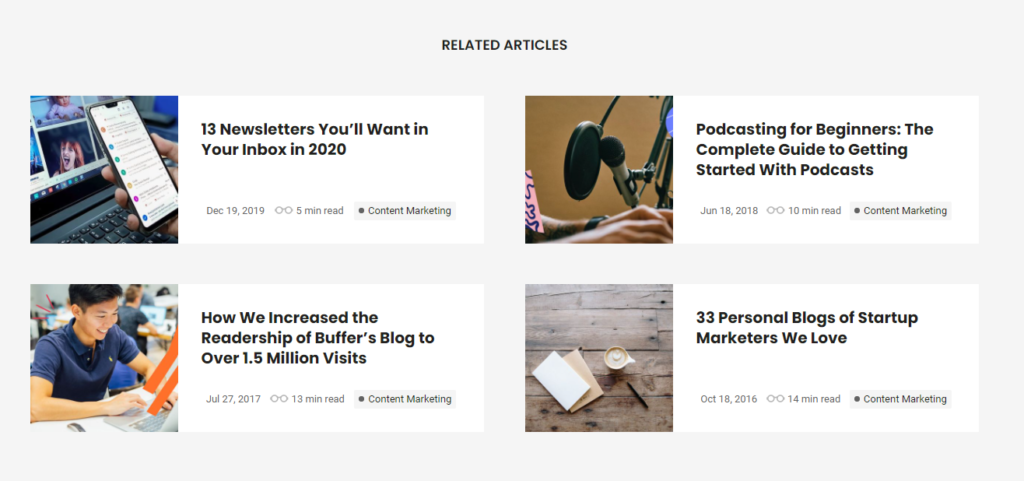
Steps like these keep readers moving through your site, and make your content a one-stop shop for readers.
Editor’s note: use “People also ask” to cover topics in-depth

The “People also ask” box can give you a hint on specific questions you might want to answer in your content to make it complete.
In fact, it’s more than a hint. Google’s pretty much telling you exactly what people who searched for your main topic (or keyword) want to know before making a decision.
Take this People also ask box for the query “what is the best SEO tool”:
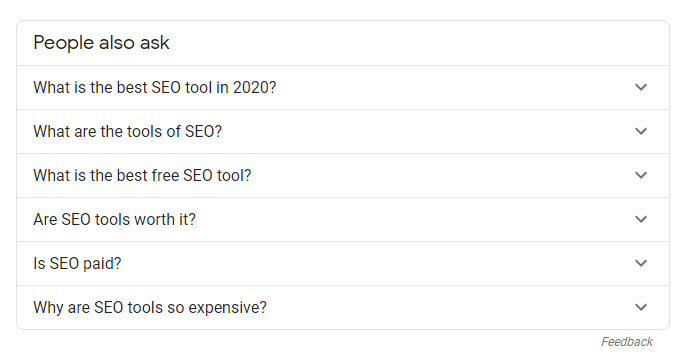
We can see that…
- “What is the best free SEO tool”
- “Are SEO tools worth it”, and
- “Why are SEO tools so expensive”
…are questions that we should be answering on our page if we want to rank for the keyword “best SEO tool”.
A lot of the time these questions will make sense as subheaders. But if not, you could always add an FAQ section at the end.
And if you’re doing that, make sure you add schema markup to grab the FAQ rich snippet.
Format for readability
You don’t need to overwhelm readers with detail to prove your expertise. Strive to keep things simple and accessible while still providing everything your readers need to know. Providing a great user experience makes it easier for readers to digest your content and boosts your expertise.
- Break up the text. By using frequent headings and bulleted lists, you make your content reader-friendly and avoid a wall of text that can cause visitors to bounce. Keep paragraphs short — no longer than three lines.
- Add visuals. Images and photos make your content look more professional, engaging visitors and boosting readership. In one study, BuzzSumo found that inserting visuals every 75 to 100 words is optimal for maximizing social shares. Always opt for high-quality visuals, and don’t forget to include alt-text.
- Use responsive design. In Q2 of 2020, nearly 52% of website traffic came from mobile devices, yet many content creators still don’t provide a mobile-responsive experience. Make sure you use responsive design to ensure that all visitors have a great experience.
Building Authority
Expertise is just part of the equation. If your content isn’t getting any traffic, links, or shares, you’re just shouting into the void.
You need other authorities and influencers to mention you as a relevant source of information in your space. That’s when you start to become recognized as an authority on your topic.
Authority means having influence because of one’s recognized knowledge or skill in a particular area. And it isn’t an either/or proposition. It’s something you grow over time.
In the online world, authority is measured by the number of other authority figures who mention and link to your content. When people come to see you as a reliable source of information on your topic, you’re an authority.
Build high-quality backlinks
Links from authoritative websites are the name of the game when it comes to growing your authority. And in 2020, there are more ways than ever to build quality links to your site. Consider some of these strategies.
Build links from authority sites. One strategy Google uses to measure page quality is ‘seed’ sites. Google looks at sites that are known to carry high authority, like Wikipedia or the New York Times. Those sites are likely to link to other high-authority sites, too. While getting a page on Wikipedia can be tough, it’s definitely worth doing if you can manage it. Guest posting on high-authority sites like Entrepreneur, Fast Company, or leading sites in your niche is a highly effective strategy to boost your site’s authority in Google’s eyes.
Create a resource hub. Creating a one-stop information hub is a great way to position yourself as an authority by giving readers all the information they need, all in one place. Check out how REI’s Expert Advice hub provides readers with guidance on any outdoor adventure they might be interested in:
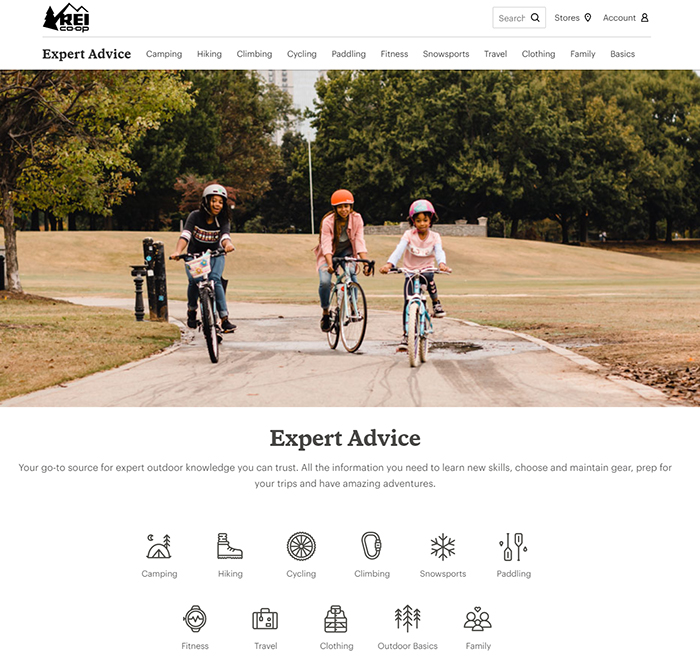
Offer a free tool. With a genuinely useful free tool, you can attract tons of backlinks, bring users back to your site again and again and reinforce your expertise on your topic. Here at Seobility, our Free SEO Checker is by far our most popular page, attracting tons of backlinks and traffic that have helped to build our presence in the SEO space:
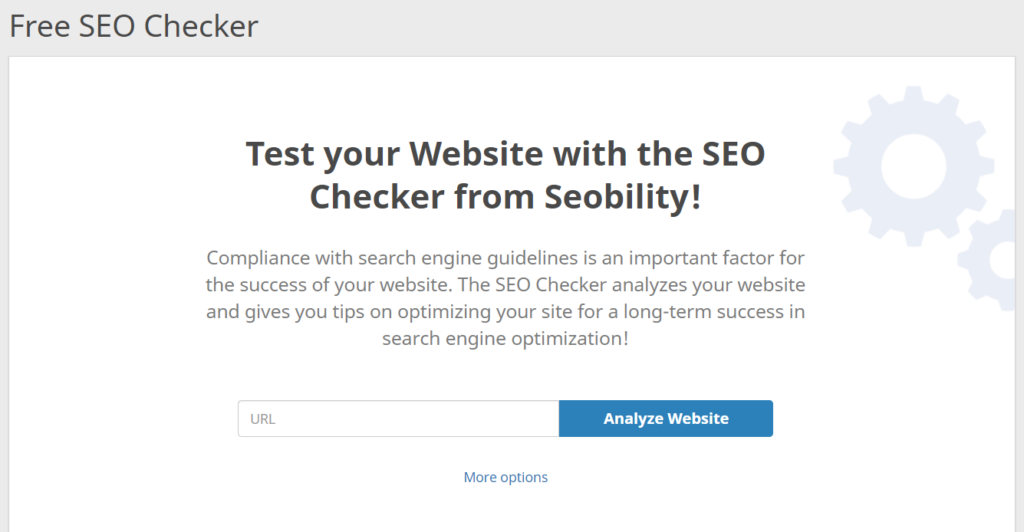
Build compelling data visualizations. There’s more data out there than ever. And creative data visualizations that help readers wrap their heads around the data are one of the most powerful ways to attract links to your content. For example, ProPublica gobbled up nearly 3,700 backlinks with their map feature visualizing the future of climate change:

Grab authoritative mentions
It’s great to get backlinks. But just being mentioned in news articles or on other authority sites will help Google recognize you as an authority.
Connect with journalists on HARO. HARO, or Help A Reporter Out, is one of the easiest ways to snag mentions in news articles and get featured in major media outlets. Signing up for an account is free, and once you’ve gotten started, you’ll get regular emails filled with plenty of opportunities to connect with journalists in your niche:
When you reach out to journalists, you want to show you’re a pro. Be sure to create a professional bio, and provide the same kind of specific, expert information you want to be known for.
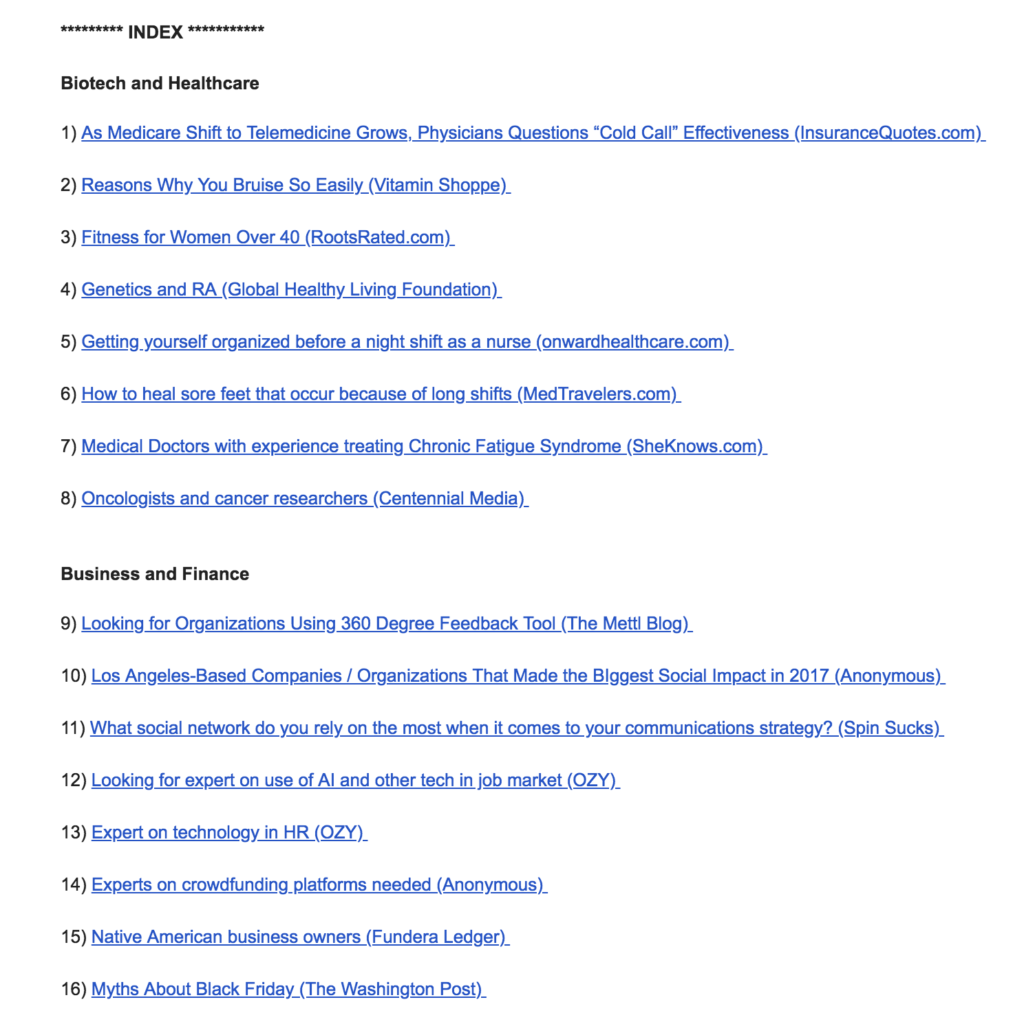
Build relationships with influencers. The fact is, people share content that they like. And if you’ve built a positive relationship with someone, they’re much more likely to view your content favorably and share it on their own. You can connect with influencers online in places like Twitter, LinkedIn, and membership groups. And the more you do it, the more success you’ll have getting great links and mentions.
Showing Experience
Experience means having first-hand experience relating to the topic of a webpage. Simply being knowledgeable on a topic or researching it thoroughly isn’t enough. After all, it’s personal experiences, anecdotes and opinions that truly make content on the web unique.
First-hand experience is a vital part of creating valuable content.
Without it, you’re just regurgitating information you’ve found online.
Product reviews are an easy example to demonstrate this point.
If you’re writing a review on a blender and all you’ve done is rewritten information found on the manufacturer’s website, your content is far from original or unique (regardless of what old-school affiliate marketers might tell you 😉).
However, if you add pictures of you using the blender, a video showing how well it blends, and provide your own opinions on its features, then you’re adding real value. This is what Google means by Experience.
The images and video of you using the blender allow potential buyers to watch it in action and give them a better idea of its dimensions and how it looks. Your own opinions and experience using it provide them with an independent review of the blender and its features.
This doesn’t just relate to product reviews, however. The same is true for any other type of webpage.
Google added an interesting table to their QRG that compares Experience to Expertise. This table gives some examples of what Google means by Experience and gives us an idea of the different situations where either Experience or Expertise is prioritized.
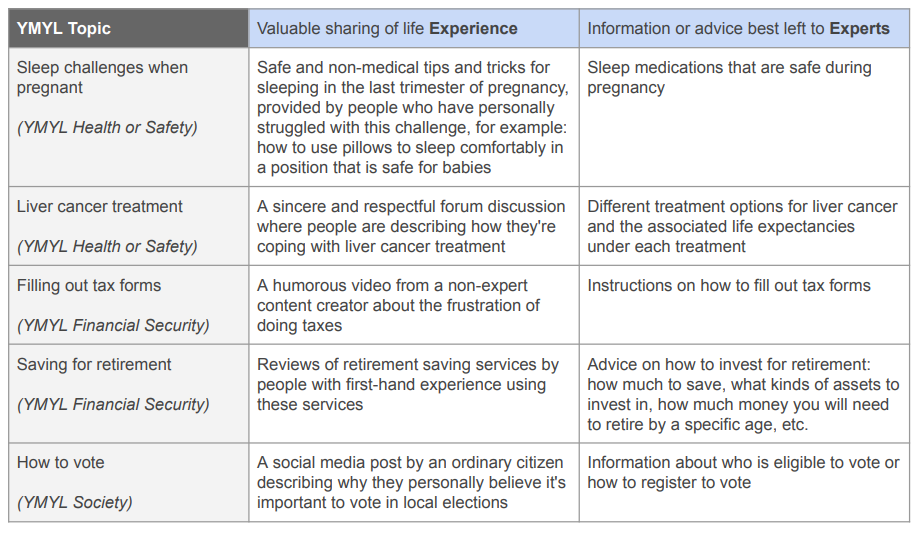
The thought behind adding Experience to E-A-T is pretty easy to understand, but there’s a difference between having experience and demonstrating it in an effective manner.
Google mentions a number of ways of demonstrating experience in its guidelines, including images, video content, and writer bios. They also state that external evidence is taken into account, including things like reviews, references, news, articles, and other sources of credible information about the website or content creator.
Demonstrate your experience in your content
Showing experience should be a natural part of creating high-quality content.
When it comes down to it, it’s your personal experiences and opinions that make a piece of content unique and valuable to a reader.
There are many ways to demonstrate first-hand experience in your content, including:
- Adding images that show first-hand experience:
This could be images of you using a product you’re reviewing or you doing something related to a page’s topic. For example, if you’re writing an article on traveling around Thailand, showing images of you in Thailand is a great way of demonstrating your experience.
Serious Eats does this very well in their product reviews. For example, in their Nespresso coffee machine review, the writer shows herself using the coffee machine throughout the article.
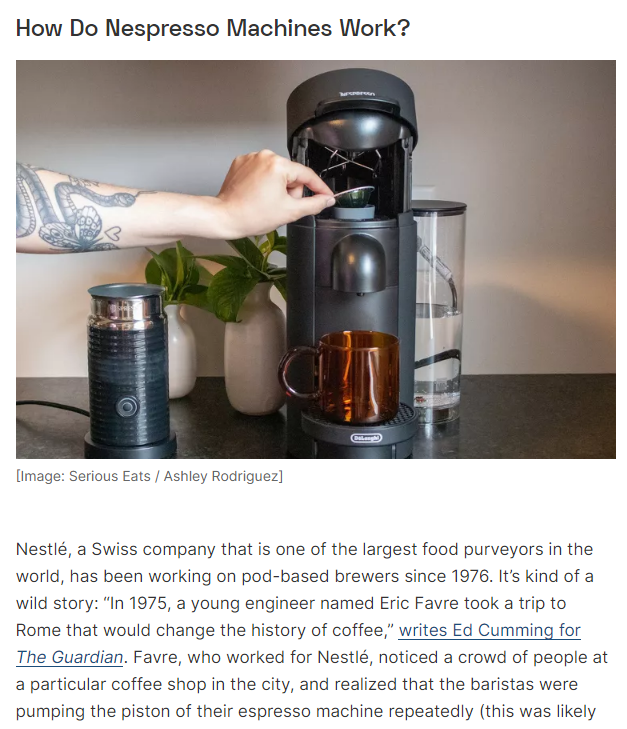
- Videos of you demonstrating your experience:
Videos work in much the same way as images. If your page is reviewing the best SEO software, you could create short videos with examples of how you use each piece of SEO software mentioned on the page.
Chef Vincenzo does this really well on his website Vincenzo’s Plate. In his post on how to make an authentic bolognese sauce, he shows himself cooking the recipe in a fifteen-minute-long video. Not only does this clearly show experience, it also makes it easy for his visitors to follow along!
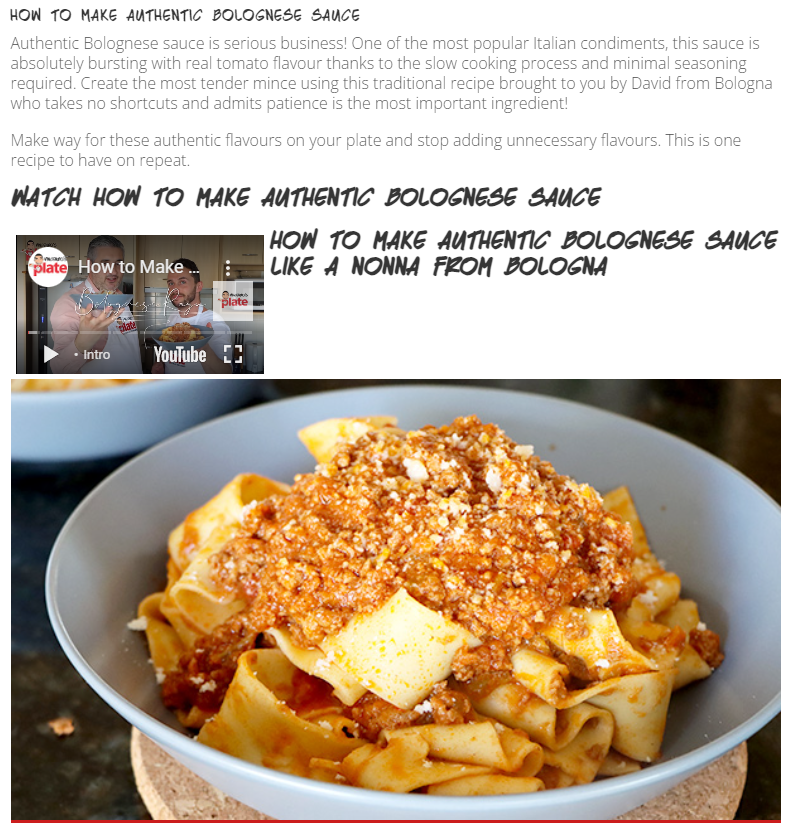
- Stating your experience at the top of the page:
Self-stated experience is far less powerful than direct proof, but it still holds weight – especially if your about us page and online reviews back up your claims. Make it clear to your readers why you’re someone they should listen to. This not only shows them you have experience with the topic, but it also allows them to make their own judgement on the opinions provided in the content.
This is something Jerry Jenkins does very well in his post on how to write a novel.
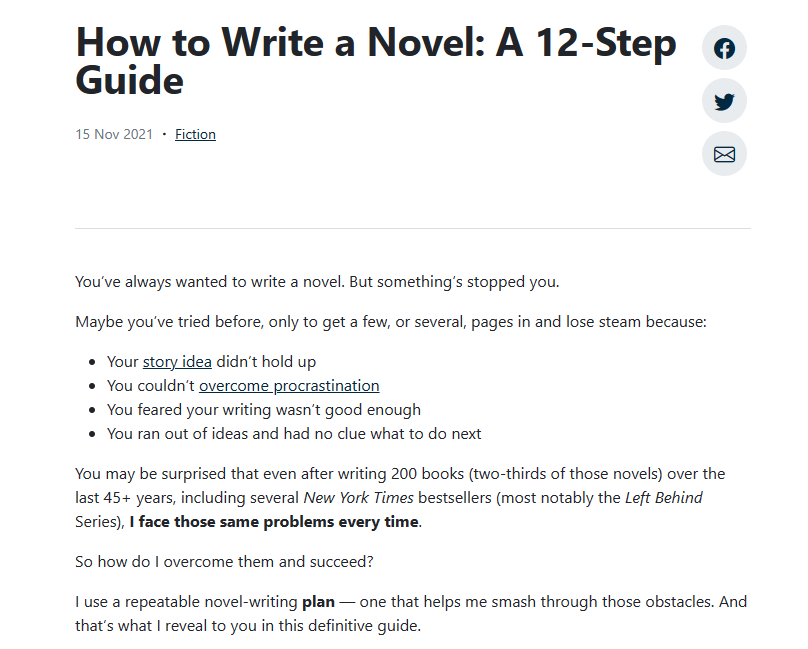
- Adding opinions and anecdotes to your content:
Adding opinions and anecdotes helps to prove your experience and adds substantial value to readers. Many people go online to research other people’s experiences and taking the time to write something unique can be very beneficial to them.
The “editor’s notes” sections on this page are a great example of this in action. 😉
Writer bio and about page
Your about page and writer bio(s) should clearly demonstrate your experience. This could be your personal experience, the experience your company/organization has, or your employee’s experience.
We dive deeper into creating an effective writer bio and about page in the section on trust.
David Nikel’s bio on Forbes is a great example showing your experience in your bio. He covers posts on Scandinavia and clearly has the experience to back it up.
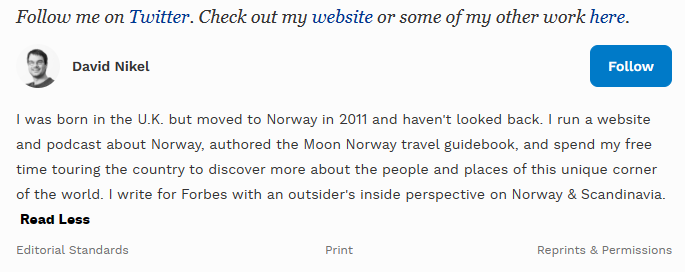
Leverage expert opinions, user comments, etc
Although you can’t avoid the fact that the main contributor should have some experience with the topic they’re writing about, adding unique quotes provided by industry experts as well as opinions provided by your readers can help make your post more valuable.
A broader range of opinions and experiences will naturally improve the quality and uniqueness of your content.
Reddit is the perfect example of this, attracting millions of daily visitors to subreddits based almost purely on the personal experiences of their users. Take their gardening subreddit, for example:
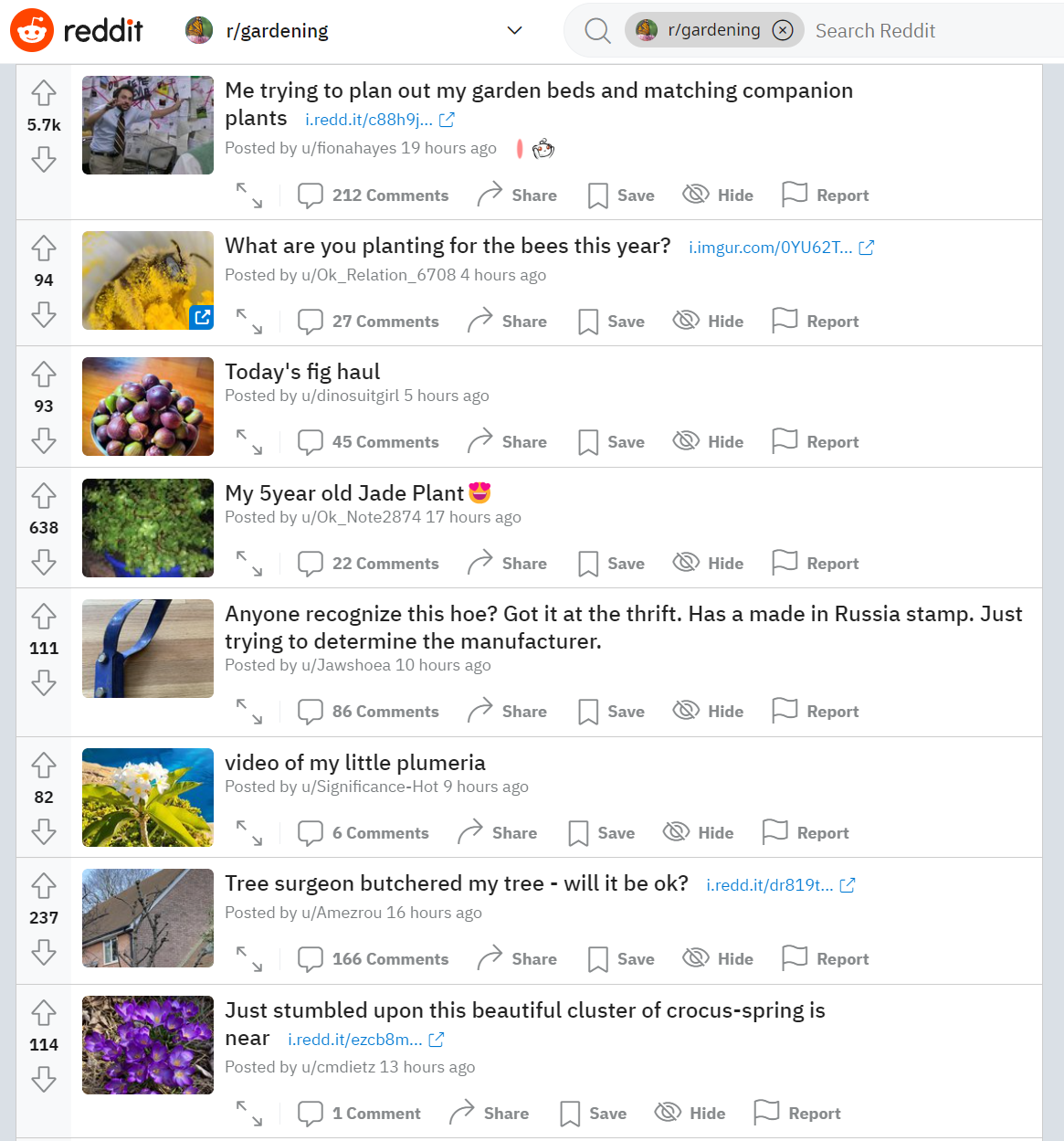
Use guest posts, customer reviews, and mentions to demonstrate experience
Earned media is still one of the most effective ways of making a name for yourself in any industry. Customer reviews, guest contributions to well-known industry publications, certification registrars and mentions are all indicators of experience.
These overlap with all other aspects of E-E-A-T too, making them all the more beneficial for your SEO efforts.
Building Trustworthiness
Trustworthiness is the most important part of E-E-A-T and Experience, Expertise and Authority are all important aspects of building trust.
Transparency is the gel that binds them together and ultimately improves your trustworthiness.
It’s not enough to have expert, authoritative content that clearly demonstrates first-hand experience. You need to show visible markers of credibility, so that readers know you’re providing advice they can rely on.
Markers like these:
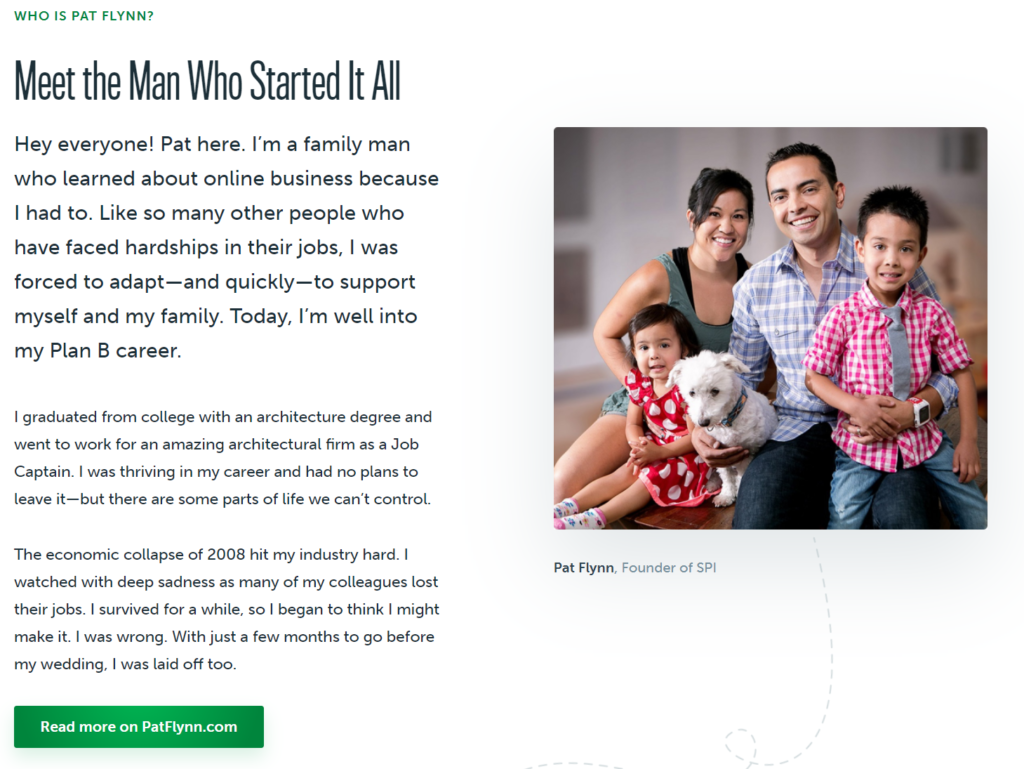
Think of it from the reader’s perspective. Without those signals, they won’t have signposts to tell them that your content is information they can rely on. And they may click off your page before they have a chance to read further.
Let’s look at some of the most important ways to build trust with your readers.
Create an author bio
Author bios are critical. Google wants to know that your content is created by trustworthy experts, and author bios help Google’s algorithms connect your content with other content you’ve written to establish your authority. On top of that, author bios also help readers quickly see why you’re qualified to write on a topic and what your experience on the topic is. Take time to make sure yours stands out, like Ann Handley does.

To check for a writer’s authority, you can always do a quick Google search. If a writer has strong credibility, you can expect to see links to lots of articles in the search results.
Don’t be put off if a writer on your team has strong expertise but hasn’t published before. But you should expect that it might take some time before they build the authority to rank well in Google.
Optimize your About page
Don’t just settle for creating a short bio. Build a focused About page. While a strong About page tells your story and what you’re about, it really shouldn’t be about you at all — it’s laser-focused on the customer and how you can transform their life. Take Girlboss. Their entire About page builds credibility for their brand by clearly communicating their mission: empowering women with the tools and relationships to take control of their futures.
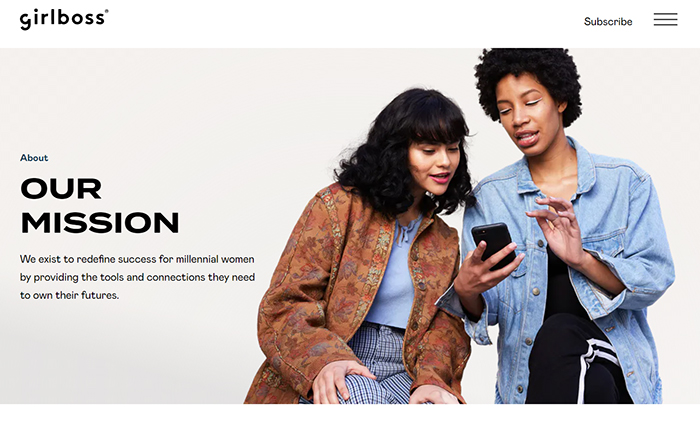
Get good reviews
Strong reviews can do a lot to boost your trustworthiness. Google looks at your online reviews in two primary ways: the number of reviews you’re getting online, and the overall sentiment of those reviews.
In general, the more reviews you can get, the better. If your company has gotten three hundred reviews on G2 or Capterra, you can expect Google to take that as a sign that you’ve built more authority than similar companies with ten or fifteen reviews. Taking steps to get people to leave reviews can only help you to build trust for your brand.
But the sentiment those reviews express is also critical. If you get three hundred mostly negative reviews, that’s a huge red flag. Google understands that every business gets a negative review every now and then, but if a significant number of people are going online to complain about your company, you’ll want to take steps to address it quickly.
When you get it right, crushing the online review game can help you build your E-E-A-T, as companies like Yesware have found:
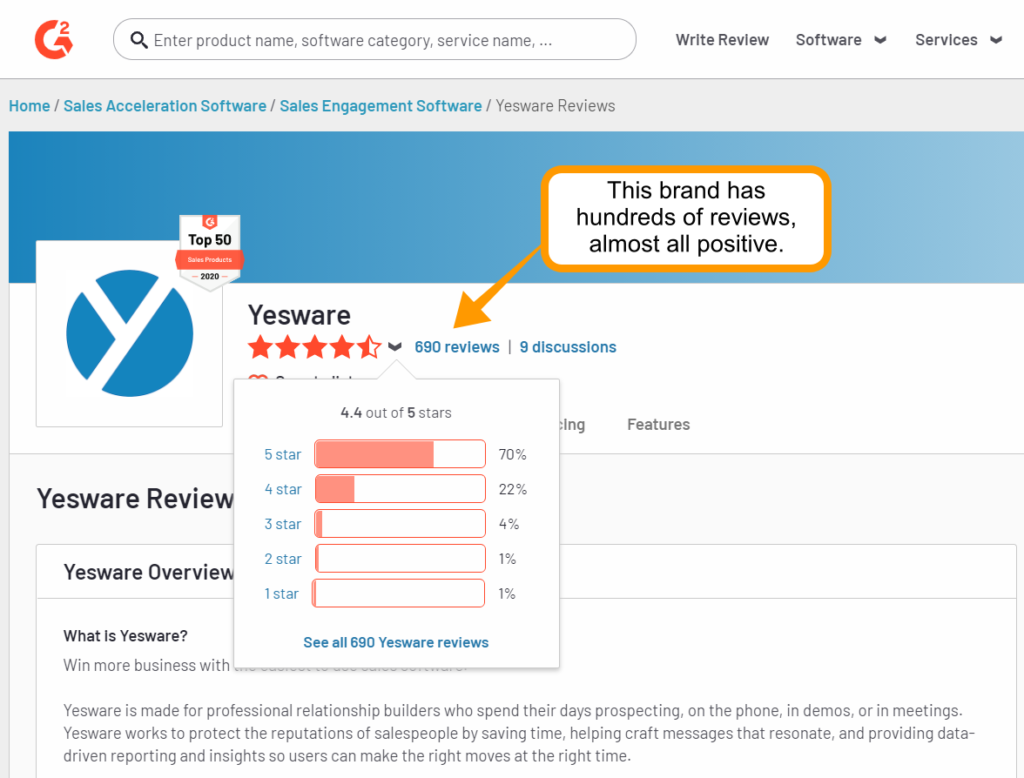
Build trust on-site
You’ll want to create a web presence that makes it easy for customers to trust you. Eliminate red flags that can cause visitors to rapidly lose trust in your brand, like these:
- Correctly implement a HTTPS domain on your site. If your website’s domain isn’t secure, Google will see that your users’ data isn’t safe from third parties which will have a negative impact on your rankings.
- Don’t make it a chore to get in touch with you. Provide contact info right on your Contact page.
- If you’re doing business on your site, have clear, customer-friendly refund and returns policies that make it easy for buyers to feel confident doing business with you. You’ll also want to provide your website privacy policy. Make it easy to find for your customers.
Editor’s note: improving E-A-T to (mostly) recover from medic

Last year I worked with a site in the supplements niche who had been slammed by medic, then obliterated by the March 2019 core update (which was kind of medic 2.0).
Between April and July we focused on improving E-A-T, and began to see recovery after the September 2019 core update. Traffic has continued to increase through 2020.

We didn’t build a single link — all the SEO work was on-site.
You’ll note that the site hasn’t completely recovered to pre-medic traffic levels. And it possibly never will. Because as I mentioned earlier, Google simply won’t surface product pages for certain queries anymore.
But it’s certainly looking a lot healthier. And when we compare the above chart to a traffic chart for the company’s main competitor (below), we can see that this is still very much a niche where Ecommerce sites are getting hammered.

So let’s look at some specific E-A-T improvements we made.
Note: due to client confidentiality I can’t reveal the site (or exact niche). So I’ll use weight loss for the examples.
1. Removed or reworded misleading or exaggerated “claims”
This is subtle but important.
Our first step was to carefully review all language on the site and reword any claims that could either be viewed as misleading, or exaggerated.
For example wording such as:
“If you use this supplement you’re guaranteed to lose a stone in 6 weeks.”
Might be changed to:
“Studies have shown that this supplement may aid weight loss, when combined with healthy eating and exercise.”
And on that note, the word “guarantee” was used on the site a lot. Now? You won’t find it anywhere.
tip: look out for potentially misleading claims in your titles and meta descriptions as well as within content.
2. Added citations for all remaining claims
Any claims that remained were backed up with links to peer reviewed studies from trusted sources.
We implemented this “Wikipedia style” with citation numbers next to each claim, and a corresponding list of the citations (with links) in the footer.
3. All product and informational pages were fact checked by a MD
After making changes to content, each page on the site was fact checked by a medical doctor with expertise in the niche.
The doctor recommended changes where appropriate. And once they were implemented we added a “fact checked by X” box at the bottom of each page with a short bio and links to his credentials.
4. Improved about us page and made finding contact information easier
We made improvements to the about us page, including photographs of the (US based) facility where the company’s products are manufactured.
Contact details — including a physical address — were added to the footer of every page.
5. Low quality pages were updated or removed
The site had some legacy, low quality informational content in a “blog” section.
Most of this content had zero search traffic and was simply removed. However, some pages which had previously received small amounts of search traffic were improved, updated with current facts/guidance, and republished.
6. Combined product variations into parent products
Each product variation had its own page on the site.
For example, if a diet pill was available in packs of 10, 20, and 50, then each of these variants would have been listed as a separate product.
We combined these into single products, and added drop down options for variations.
7. Improved technical SEO and site speed
As part of the process of improving the site we conducted a full technical SEO audit and made improvements where required.
We also improved the speed of the site by implementing caching, compressing images, and reducing code bloat.
Find out how to audit your site and improve its SEO here.
In summary
By taking a critical look at the site, evaluating claims that may be exaggerated or misleading, and ensuring that all information was factually accurate and properly cited, we were able to improve E-A-T and help it recover from medic.

Bottom line: everything you can do to make your site more trustworthy is good for users, and good for Google.
Bottom, bottom line: trust matters a LOT.
Start Building E-E-A-T Today
Now that you know how Google measures experience, expertise, authority, and trustworthiness, it’s time to get to work.
Where does your website shine? Where are you lacking? Commit to taking one concrete step each day to improve your E-E-A-T, starting right now.
Remember, building expertise and authority are keys to grabbing the top spot in Google’s SERPs. So get to it!
PS: Get blog updates straight to your inbox!